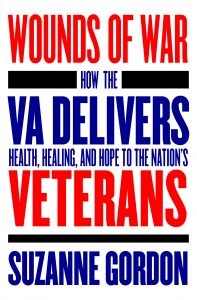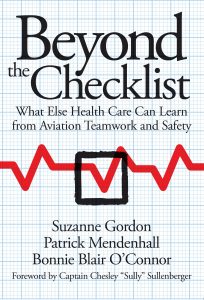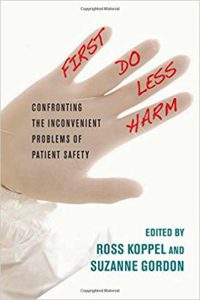There are links to purchase books online below, but when possible, we encourage you to visit your local independent bookstore.
Our Veterans
Winners, Losers, Friends, and Enemies on the New Terrain of Veterans Affairs
““This chilling account explores the physical, economic and psychological consequences of military service on veteran health and takes a critical look at the many players involved in shaping veteran life in the United States.”
~ New York Times Book Review
“As this book reveals, too many men and women in the military are exposed, callously and carelessly, to a toxic work environment. Their service-related problems can lead to unemployment, homelessness, and high suicide rates. That’s why veterans need more real friends, in Congress and the public, who will better defend the lifesaving programs of the Department of Veterans Affairs (VA). Our Veterans is a call to action by everyone concerned about health equity and educational opportunity for all Americans.”
Michael Blecker
executive director of Swords to Plowshares, Vietnam veteran

Wounds of War
How the VA Delivers Health, Healing, and Hope to the Nation’s Veterans
U.S. military conflicts abroad have left nine million Americans dependent on the Veterans Health Administration (VHA) for medical care. Their “wounds of war” are treated by the largest hospital system in the country—one that has come under fire from critics in the White House, on Capitol Hill, and in the nation’s media. The resulting public debate about the future of veterans’ health care has pitted VHA patients and their care-givers against politicians and policy-makers who believe that former military personnel would be better served by private health care providers.
The Battle for Veterans’ Healthcare:
Dispatches from the Frontlines of Policy Making and Patient Care
In The Battle for Veterans’ Healthcare, award-winning author Suzanne Gordon takes us to the front lines of federal policymaking and healthcare delivery, as it affects millions of Americans whose military service makes them eligible for Veterans Health Administration (VHA) coverage.
Beyond the Checklist
The U.S. healthcare system is now spending many millions of dollars to improve “patient safety” and “inter-professional practice.” Nevertheless, an estimated 250,000 patients still succumb to preventable medical errors every year. How can health care providers reduce the terrible financial and human toll of medical errors and injuries that harm rather than heal?
Buy the book:
First, Do Less Harm: Confronting the Inconvenient Problems of Patient Safety
Each year, hospital-acquired infections, prescribing and treatment errors, lost documents and test reports, communication failures, and other problems have caused thousands of deaths in the United States, added millions of days to patients’ hospital stays, and cost Americans tens of billions of dollars. Despite (and sometimes because of) new medical information technology and numerous well-intentioned initiatives to address these problems, threats to patient safety remain, and in some areas are on the rise.
Buy the book:
From Silence to Voice: What Nurses Know and Must Communicate to the Public (The Culture and Politics of Health Care Work)
For more than a decade, From Silence to Voice has been providing nurses with communication tools they can use to win the resources and respect they deserve. Now, in a timely third edition, authors Bernice Buresh and Suzanne Gordon focus on how nurses can describe and frame their work to seize unprecedented opportunities to advance their profession and lead improvements in health care systems.
Buy the book:
Collaborative Caring: Stories and Reflections on Teamwork in Health Care
Teamwork is essential to improving the quality of patient care and reducing medical errors and injuries. But how does teamwork really function? And what are the barriers that sometimes prevent smart, well-intentioned people from building and sustaining effective teams? Collaborative Caring takes an unusual approach to the topic of teamwork. Editors Suzanne Gordon, Dr. David L. Feldman, and Dr. Michael Leonard have gathered fifty engaging first-person narratives provided by people from various health care professions.
Buy the book:
Nursing against the Odds: How Health Care Cost Cutting, Media Stereotypes, and Medical Hubris Undermine Nurses and Patient Care
In the United States and throughout the industrialized world, just as the population of older and sicker patients is about to explode, we have a major shortage of nurses. Why are so many RNs dropping out of health care’s largest profession? How will the lack of skilled, experienced caregivers affect patients? These are some of the questions addressed by Suzanne Gordon’s definitive account of the world’s nursing crisis.
Buy the book:
Life Support: Three Nurses on the Front Lines
In this book, Suzanne Gordon describes the everyday work of three RNs in Boston―a nurse practitioner, an oncology nurse, and a clinical nurse specialist on a medical unit. At a time when nursing is often undervalued and nurses themselves in short supply, Life Support provides a vivid, engaging, and intimate portrait of health care’s largest profession and the important role it plays in patients’ lives.
Buy the book:
When Chicken Soup Isn’t Enough: Stories of Nurses Standing Up for Themselves, Their Patients, and Their Profession
The reassuring bromides of “chicken soup for the soul” provide little solace for nurses―and the people they serve―in real-life hospitals, nursing homes, schools of nursing, and other settings. In the minefield of modern health care, there are myriad obstacles to quality patient care―including work overload, inadequate funds for nursing education and research, and poor communication between and within the professions, to name only a few.
Buy the book:
Safety in Numbers: Nurse-to-Patient Ratios and the Future of Health Care
Legally mandated nurse-to-patient ratios are one of the most controversial topics in health care today. Ratio advocates believe that minimum staffing levels are essential for quality care, better working conditions, and higher rates of RN recruitment and retention that would alleviate the current global nursing shortage. Opponents claim that ratios will unfairly burden hospital budgets, while reducing management flexibility in addressing patient needs.
Buy the book:
Bedside Manners: Play and Workbook
In recent years, there has been growing awareness of the need for interprofessional cooperation in healthcare. Countless studies have shown that genuine teamwork and team intelligence are critical to patient safety. Poor communication among health care personnel is a major factor in hospital errors, even more so than the level of staff competence and experience. This is why many schools for health professionals and major health care employers now promote interprofessional education and cooperation.
Buy the book:
The Complexities of Care: Nursing Reconsidered
“Nursing, everyone believes, is the caring profession. Texts on caring line the walls of nursing schools and student shelves. Indeed, the discipline of nursing is often known as the ‘caring science.’ Because of their caring reputation, nurses top the polls as the most-trustworthy professionals. Yet, in spite of what seems to be an endless outpouring of public support, in almost every country in the world nursing is under threat, in the practice setting and in the academic sector. Indeed, its standing as a regulated profession is constantly challenged.
Buy the book:












